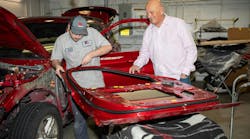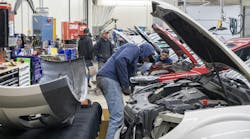In late 2016, social media sites like Facebook, Twitter, Instagram and YouTube added live features that opened the doors for businesses to connect on a more personal and instant level with consumers. Margaret Klemmer, who is part of the executive team at industry marketing firm Autoshop Solutions, says the live video features can showcase education and honesty behind a collision repair shop, which can result in building a strong, loyal clientele. Videos can be taken directly in the shop, and staff can give tours of the facility and offer real-time assessment of a vehicle.
And many shop operators are already finding unique ways to utilize the technology to connect with customers. Bogi Lateiner, a mechanical repair shop owner and star of Velocity’s All Girls Garage, not only has used live features to establish herself as an expert and build a loyal customer base, but she also has utilized Facebook Live in an industry-wide project in conjunction with 3M and BASF to raise awareness of women in the industry. Lateiner and a team of about 80 women are restoring a 1957 Chevrolet truck that will be unveiled at BASF’s 2017 SEMA Show booth in November.
“When you do a live video, it feels like [customers] are having a conversation with you versus watching a scripted video,” Lateiner says.
The Future of Social Media?
Facebook and Twitter rolled out live video in 2016 as a way for site users to connect instantly and more personally around the globe. Upon launching the feature, Facebook saw that users commented more than 10 times more on live videos than regular videos. Five filters for the video creator were also introduced along with reactions like “Love,” “Haha,” “Wow,” “Sad” and “Angry” for viewers to honestly interact to the video.
Twitter jumped on the live bandwagon in December 2016 when the company announced the ability to post live videos on Twitter that were powered by Periscope, previously a separate application used for live videos.
“It's like having a skype conversation with lots and lots of people.”
—Bogi Lateiner, Owner, 180 Degrees Automotive
Tips for Going Live
Using the live features is simple, Lateiner says. She simply logs into her Facebook and clicks a button that says “live.” Upon going live, she recommends users only write a brief two to three sentence description of the video to avoid customers losing interest.
Video creators should always be responding to the audience’s comments and questions that scroll alongside or at the bottom of the video. Lateiner says it is important even just to say “Hi” so the live video becomes more like a face-to-face conversation.
“It’s like having a Skype conversation with lots and lots of people,” she says. “It’s important to respond to any comments or questions that come through on the live feed even if it is just to say hello.”
Lateiner recommends shops use the videos for attracting new customers and engaging on a personal level with existing customers. The fact that the videos are archived makes it easy to do both. She utilizes live videos to engage with her fan base from her days on All Girls Garage but also uses the Chevy truck build updates to engage with her existing customers.
Lateiner’s live videos target a male and female audience with emphasis on women in the industry. For example, her latest posts include showing a girl bust a lug nut loose in a women’s car care class and campaigns like “Brakes for Breasts 2016.”
Jeanna Williams at Auto-Republic Collision Repair Shop in San Antonio, Texas, says her shop uses Instagram Live once per week for when her team paints vehicles. The shop has over 370 posts with more than 1,000 followers.
Williams says that the live videos do help for generating some new customers because anyone curious about the shop from hearing it word of mouth usually go to social media sites first.
Maximize the Use of Live
Klemmer says these features are an emerging market for collision repair shops and there are several considerations to take. Problems that might prevent collision shops from using the features include the large time gap between when the customer initially dropped their car off for a repair and when they come back to pick up the fixed product.
Klemmer says shops with primarily insurance work might also run into more difficulties as it can be more difficult to form a connection that leads to work further down the line.
Despite not seeing a high demand for Facebook Live with her customers, Klemmer says video is the next wave of social media because the platform is continuing to evolve, despite being in its infancy.



